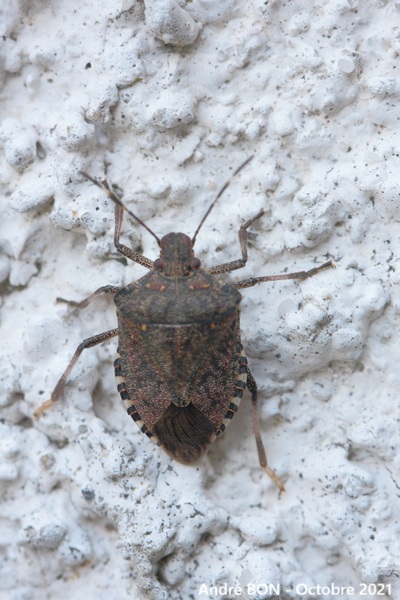
| Brown Marmorated Stink Bug (Halyomorpha halys (Stål, 1855)) |

|
|
Scientific name: Halyomorpha halys (Stål, 1855) Common name: Brown Marmorated Stink Bug French name: Punaise diabolique, Punaise marbrée. Order: Heteroptera Family: Pentatomidae Wingspan : Length: 12 to 17 mm; Width: 7 to 10 mm. Biotope: Cultivated areas, orchards. Brown Marmorated Stink Bugs can cause damage to fruits and vegetables. Geographic area: Native to East Asia, China, Japan, Korea, the Brown Marmorated Stink Bug was introduced to North America (1996), Europe (2004) and South America (2017). Observation period : All year round. Adults overwinter in natural shelters or human-made structures. There are several generations per year depending on the temperature, often two in temperate regions and up to six in warmer regions. |
This greyish-brown coloured bug has its black antennae marked with two white rings, the first at the base of article 4, the second from the tip of article 4 to the base of article 5. The lateral edges of the abdomen, or connexivum, are marked with black and white. The white markings are triangular in shape. The upper part of the body has darker punctuation. The ventral surface is very sparsely punctuated and there is no ventral spine. There are five larval stages before the adult stage. The larvae have spines in front of their eyes, on the sides of their thorax, and on their femurs. Rhaphigaster nebulosa has three white or yellowish rings on segments 3, 4 and 5 of the antennae (the ring on segment 3 is sometimes just visible). The white markings of Rhaphigaster nebulosa's connexivum are square in shape. |
| [To know more about the Brown Marmorated Stink Bug] [Top] |

|
The rings of the antennae and the triangular shape of the white markings of the connexivum leave no doubt as to the identification of the Brown Marmorated Stink Bug. |